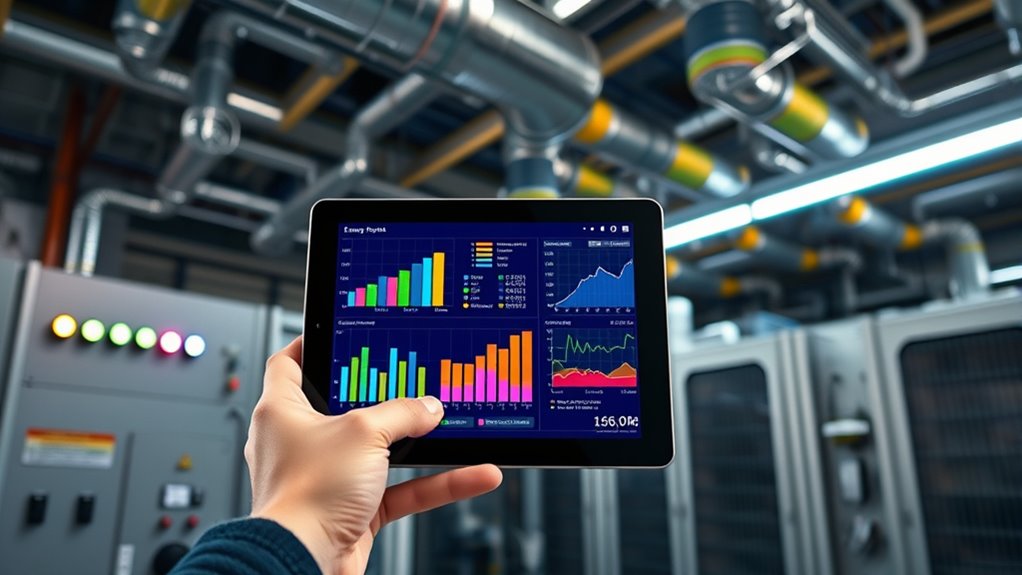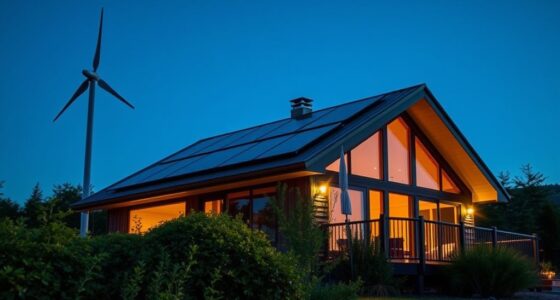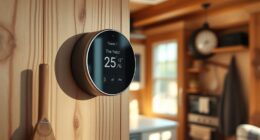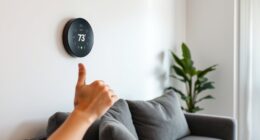To identify HVAC inefficiencies using energy reports, examine patterns like sudden spikes in energy use or uneven temperature distribution across rooms. Look for signs of duct leaks, such as inconsistent airflow or higher consumption without weather changes. Use the data to spot early signs of equipment issues or faulty thermostats. By analyzing these trends, you can schedule proactive maintenance and optimize system performance—continue exploring to discover more ways to improve your HVAC efficiency.
Key Takeaways
- Analyze energy consumption patterns for unusual spikes indicating equipment inefficiency or duct leaks.
- Compare temperature setpoints and usage data from smart thermostats to detect inconsistent system performance.
- Review reports for uneven temperature distribution across zones to identify duct sealing issues.
- Track peak energy usage periods to pinpoint outdated or malfunctioning HVAC components needing maintenance.
- Use energy trend data to assess compliance and optimize system operation for improved efficiency and cost savings.

Energy reports are a powerful tool for identifying HVAC problems before they become costly repairs. These reports provide detailed insights into your system’s performance, highlighting patterns and anomalies that might otherwise go unnoticed. When you regularly review your energy data, you can catch inefficiencies early, saving money and extending the lifespan of your equipment. One of the most effective ways to leverage energy reports is by focusing on smart thermostats. These devices collect precise data on temperature settings, usage patterns, and energy consumption, offering real-time feedback that helps you optimize your heating and cooling. If you notice frequent adjustments or inconsistent temperature readings, it may signal underlying issues such as duct leakage or poor insulation. Smart thermostats also enable you to set schedules and automate temperature changes, which can reduce unnecessary energy use and highlight areas where your HVAC system isn’t performing efficiently.
Duct leakage is another critical factor that energy reports can help you identify. Leaky ducts waste a significant amount of conditioned air, forcing your system to work harder and increasing energy costs. When reviewing your energy data, look for signs like uneven temperatures across different rooms or sudden spikes in energy consumption without a change in outdoor weather. These indicators often point to duct leakage or poorly sealed ductwork. By pinpointing these issues early, you can schedule repairs or upgrades to improve airflow and efficiency. Sealing duct leaks not only saves energy but also enhances comfort, as it ensures that conditioned air reaches all parts of your building uniformly.
Furthermore, energy reports can reveal usage trends that help you understand when your HVAC system is underperforming. For example, if you see higher-than-average energy consumption during specific months or times of day, it could be due to duct leakage, outdated equipment, or improper thermostat calibration. Regularly analyzing this data allows you to schedule maintenance proactively, rather than waiting for breakdowns or spikes in your utility bill. Additionally, integrating smart thermostats with your energy reports creates a feedback loop that makes ongoing optimization easier. These systems can automatically adjust settings based on usage patterns, detect anomalies, and even send alerts if they identify potential problems like duct leakage or system inefficiencies.
Being aware of local regulations and guidelines can also help you ensure that your HVAC system is compliant and operating within legal standards. In essence, using energy reports effectively means paying attention to data points related to smart thermostat performance and ductwork integrity. By doing so, you can address issues early, improve your HVAC system’s efficiency, and avoid expensive repairs down the line. With a proactive approach rooted in detailed energy analysis, you gain greater control over your energy consumption, comfort, and costs.
Frequently Asked Questions
What Are Common Signs of HVAC Inefficiencies Not Shown in Reports?
You might notice inconsistent temperatures, strange noises, or increased energy bills, which reports may not show. These signs suggest HVAC inefficiencies that manual inspections can reveal, like worn-out parts or leaks. Relying on predictive maintenance helps spot issues early before energy reports flag problems, ensuring your system stays efficient. Regular inspections and proactive maintenance are key to catching problems that reports might overlook, keeping your HVAC running smoothly.
How Often Should Energy Reports Be Reviewed for Optimal HVAC Maintenance?
You should review energy reports at least monthly to catch inefficiencies early and keep your HVAC running smoothly. Regular review helps you spot trends and schedule maintenance proactively, avoiding costly breakdowns. Prioritize report accuracy to make informed decisions. Don’t wait months—by checking reports monthly, you ensure your HVAC system stays efficient, saving energy and money while preventing minor issues from turning into major repairs.
Can Energy Reports Identify Issues Caused by External Environmental Factors?
Yes, energy reports can identify issues caused by external environmental influences. You’ll notice unusual energy consumption spikes during extreme weather, like heatwaves or cold snaps, indicating environmental impacts on your HVAC system. By analyzing patterns in the reports, you can determine if external factors are causing inefficiencies, enabling you to adjust settings or schedule maintenance accordingly. This proactive approach helps optimize system performance despite external environmental influences.
What Tools Complement Energy Reports for Comprehensive HVAC Diagnostics?
You can complement energy reports with tools like thermal imaging and airflow measurement for thorough HVAC diagnostics. Thermal imaging helps you spot temperature differences and insulation issues, while airflow measurement pinpoints problems with ductwork or vents. Using these tools alongside energy reports gives you a clearer picture of inefficiencies, allowing you to target repairs precisely, improve system performance, and reduce energy costs effectively.
How Do Building Occupancy Patterns Affect Energy Report Analysis?
You should consider how occupancy variance and usage fluctuations impact your energy report analysis. If your building has inconsistent occupancy, energy use patterns will vary, making it harder to pinpoint inefficiencies. Track these fluctuations over time to identify trends and adjust your HVAC settings accordingly. Recognizing periods of low or high occupancy helps optimize system performance, ensuring energy is used efficiently without sacrificing comfort.
Conclusion
By analyzing energy reports, you can uncover hidden HVAC inefficiencies that might be secretly draining your energy and increasing costs. Think about it—what if these reports reveal problems you never knew existed? Addressing these issues not only saves money but also creates a more comfortable environment. Don’t underestimate the power of data; it’s like having a secret weapon that can transform your system and boost efficiency. Take action today—your wallet and comfort depend on it.









